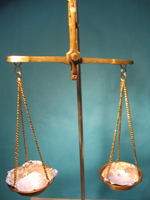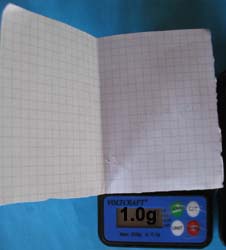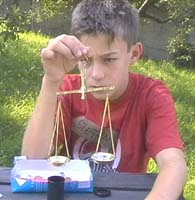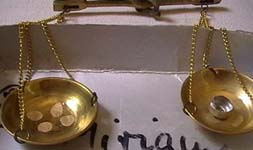
 .
.


W08 Water has a
mass - Learn how to handle a two pan scale, make weights(.
In
your first experiment you learned how to measure the volume of water.
Beside the volume each substance has a characteristic mass.
For weighing two pan scales (Photo 1) were used in Egypt more than
4000 years
ago. Modern versions of such scales you still find in most schools nowadays
(Photo 2). You will learn quickly how to use it and how to make weights
using square paper from your exercise book.
On a digital pocket
scale (Photo 3) you find that 1/4 of a DIN A
4 paper sheet weighs a little bid more than 1 gramm. (60 squares =
1000 mg).
Material
Two
pan scale with a stand (Photo 1), ruler,
1 sheet of DIN A 4 square paper, aluminium foil, scissors, insulin
syringe 1 ml (only from a pharmacy!),
water samples.
Experiment
1. Fix the scale at a stand.
2. Look whether it
is in equilibrium
like seen in Photo 2. If one of the pans is higher than the other,
add a piece of aluminium foil of the right size to it.
3. Cut the square
paper into 4 parts of equal size. Fold one of it and place it in the left
pan.
4. Add 1.0 ml water
to the right pan.
5. Cut off the number
of squares needed for the paper weight to balance the scale again.
6. Count / calculate,
how many squares equal 10 ml ´water.
7. Cheque how many
sqares are needed on one pan to unbalance the scale.
8. Leave the scale
with water and paper weight until it is no longer balanced.
Results
a) 1 ml tap water balance a paper
weight witht ........... squares.
b) The
scale can be unbalanced by ........mg of paper weight.
c) After ..... hours the pan with
the paper weight is deeper.
Explanationg
1 ml freshwater weighs exactly
1.0 g. So the paper weight is also 1.0 g (= 1000 mg). To get lighter weights
you can cut it.
The weight of the water decreases
due to evaporation. This means that water is of limited use as weight.